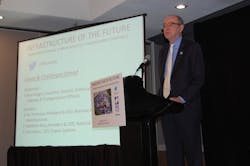Bud Wright, AASHTO’s executive director, (seen at right speaking at an infrastructure summit back in 2013) laid things out in pretty stark terms – especially where the needs of the freight industry are concerned.
“Investing in that infrastructure will require some gutsy decisions on Capitol Hill about how to pay for it, but the bottom line is this: We have a choice between making the country stronger or making it weaker,” he wrote in a recent opinion piece.
“We can pay to fix our transportation systems, and then reap the payback that comes from oiling the machinery of commerce. Or we will certainly pay higher and higher costs from slower commuter and freight travel, more highway crashes and deaths, more disposable income lost from extra hours stuck on roads, more car and truck repairs from jostling on broken pavement,” Wright noted.
Yet, according to AASHTO’s and APTA’s numbers at least, getting U.S. transportation infrastructure up to snuff isn’t going to be cheap.To meet current demand, the research conducted by both groups indicates it’ll require an annual capital investment over six years of some $120 billion in the nation’s highway and bridge network and $43 billion in America’s public transportation infrastructure.
To meet those combined surface transportation needs, it would require an investment of $163 billion investment per year in surface transportation over a six year period. Current funding levels, by the way, aren’t near those dollar levels, with $83 billion being invested in roads and bridges today along with $17.1 billion being invested in public transit.
The new report also noted that 64,000 structurally deficient bridges are still operating across the U.S. – and that’s after that category shrank by 43% from 1994 to 2013 following federal and state efforts to target older bridge structures.
Then there’s the Federal Transit Administration’s annual State of Good Repair Assessment, which indicates there’s a “repair backlog” estimated at $87.7 billion to get public transit systems up to snuff.
Now, it’s fair to say there’s disagreement over not only the amount of funds transportation infrastructure upkeep actually needs but whether federal and state spending to date is being managed properly (the Reason Foundation’s 21st annual highway report offers one such contrarian view.)Yet AASHTO’s Wright offers this compelling rejoinder: “There is little disagreement about the value of transportation; the business community, trade unions, commercial truck drivers and numerous associations support greater [transportation] investment,” he stressed. “The key is reaching consensus on Capitol Hill … to help decision-makers better understand what’s at stake in deciding on a long-term, sustainable stream of revenue to support transportation infrastructure.”
For starters, he warned, the direct federal revenue stream for most transportation projects – the highway trust fund (HTF), comprised of various excise taxes on motor fuels and truck equipment – is nowhere close to keeping pace with the amounts federal programs now pay states for capital investment in roads, bridges and mass transit systems.
In particular, Wright pointed to the big rebound in freight volumes now underway in the U.S. and how that will impact transportation infrastructure. He said freight ton miles are expected to grow 72% from 2015 to 2040, putting ever more big-rigs on often-crowded highways.
He added that highway and bridge estimates in AASHTO’s and APTA’s report are based on a rate of travel growth of 1% per year in vehicle miles of travel. Yet this year, Wright stressed that America is returning, for the first time since the “Great Recession” began in 2008, to the 3 trillion mile-level of motor vehicle travel – a rebound spurred in part by falling gasoline prices and increased employment.“Just shoring up the HTF to maintain current levels will not make much of a dent in [traffic] congestion that saps economic vitality,” Wright emphasized. “It shows that a flat-level federal program will not keep pace with increased vehicle miles traveled on highways or with demands for public transportation services, much less close the investment gap that already exists.”
Yet coming up with billions in added transportation funding may be an impossible task, especially with much of the general public – much less Congressional members of both political parties – seemingly dead-set against hiking fuel taxes.
We’ll see how the transportation funding issue plays out when the new Republican-controlled Congress convenes next year.




